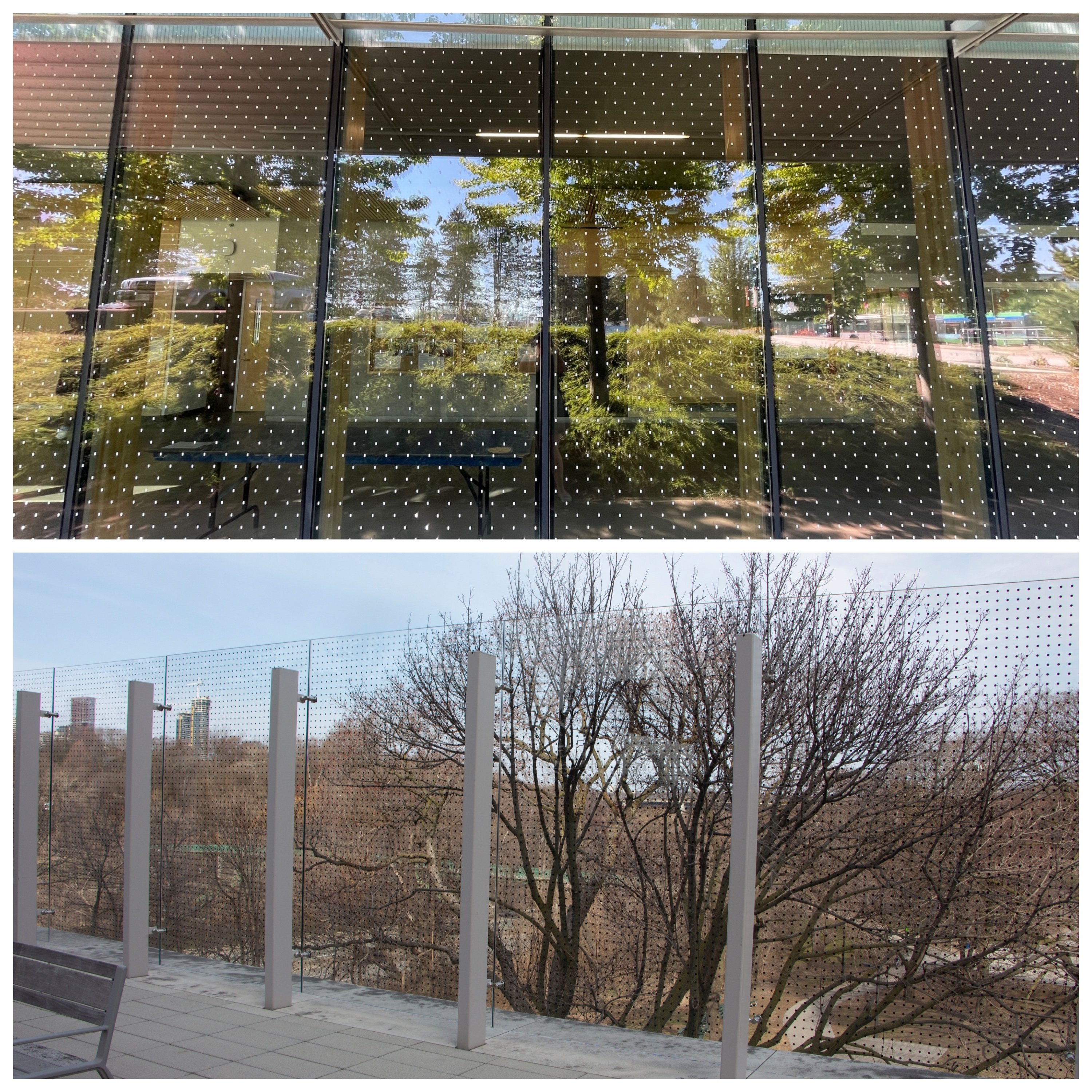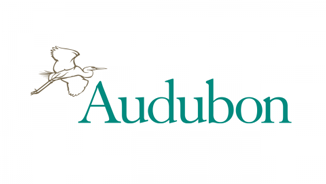
Posted May 8th 2023
Why Birds Collide with Glass: Reflection Vs. Fly-Through Glass
Bird collisions are a serious problem. As many as one billion birds die each year in North America as a result of glass collisions. That’s a staggering number, but it’s one that we can all do something about.
But before you can effectively mitigate bird collisions at your home or business, you must first identify what collision danger issue you need to treat: fly-through or reflection.Today’s blog will discuss these two main properties of glass known to cause collisions and how Feather Friendly’s® scientifically tested and approved solutions protect against each.
Reflective Surfaces
Reflective glass or mirrored areas are the most common collision problem for birds. By reflecting the surrounding habitat and sky, reflective glass surfaces mislead birds into thinking it’s a real part of their environment and thus many consequently collide with them at full speed.
Reflection is an issue that happens on the outermost surface of the glass. Because of the angle of the sun, large portions of the day render any applications or treatments on inside surfaces completely invisible. It’s for this same reason, closing blinds aren’t sufficient in mitigating collisions. While it may block some UV rays and make it harder for birds to see reflections from the inside, it doesn’t solve the problem entirely as birds will still be able to see reflections from outside if they fly high or low enough.
See for yourself – put a Post-It note inside your window and check on it outside throughout the day to see how it “disappears”.
Feather Friendly® Glass Solutions for Reflective Surfaces
Feather Friendly® Light Grey deterrent markers are recommended for reflection glass or mirrored areas. In these cases, light grey offers a great contrast for this issue. Contrast is one of the key elements for effective solutions. If you can imagine a pane of glass that is reflecting green habitat, dark or low contrast markers are not as visible as light and high contrast markers are. For Reflective glass, markers must be placed on the exterior surface of the glass where the issue is happening, making them more effective at preventing collisions from the first-surface side.
Each of our DIY, Pro DIY, and Commercial Solutions are available in light grey so you can ensure avian species are aware of your reflective glass surfaces and helps prevent collisions no matter the size of your project.
Fly-Through Surfaces
Fly-through is when birds can see a habitat or sky that really does exist on the other side but do not realize the glass is a solid barrier preventing them from reaching it, such as on clear glass railing systems or glass walkways. And because the number of glass facades is so great, the toll these glass surfaces take on avian species is devastating.
Even humans get confused by fly-through surfaces without visual markers. Glass panel fences lacking vision strips or other cues make it incredibly difficult to tell where the glass surface starts and ends. If we can’t handle this type of ambiguity as humans, how can we expect birds to do so? Just like humans need vision strips to navigate glass barriers, birds require Feather Friendly® markers to alert them to the presence of clear solid surfaces.
Feather Friendly® Glass Solutions for Fly-Through Surfaces
If your glass has fly-through, Feather Friendly® Black deterrent markers are the scientifically proven option to mitigate collisions. Unlike reflective glass, black markers for fly-through offer better contrast and in some circumstances, the markers can be applied to either side of the glass due to the dynamic of seeing through both sides. In circumstances where our consultation has determined that markers can be applied to the interior surface, it can save on logistics and equipment costs.
Feather Friendly’s® DIY, Pro DIY, and Commercial Solutions are available in black so you can ensure local and migrating bird species are protected from your fly-through surfaces.
What if I have Reflective and Fly-Through Surfaces?
There are some instances when you will have both a reflection and a fly-through issue. Normally, in this case, we recommend applying Feather Friendly’s® Light Grey markers to the exterior surface, but since every project is unique, especially if you are dealing with combination glass, we are happy to help you determine which solution best meets your needs.
4 Things to Consider Before Your Next Collision Mitigation Project
Once you’ve identified the type of collision danger you must treat, there are 4 additional elements that will ensure your bird collision mitigation project is a success.
Appropriate Spacing
Acclaimed for their flying skills, birds can fit through small spaces at high speeds. Thus, spacing is a central element in establishing effective collision prevention. If the gap between the markers is too large, birds believe they can fit through the space and attempt to fly through. The closer together the spacing, the better the protection for smaller bird species like hummingbirds, bushtits, and goldfinches.
The best level of protection is to use a marker no smaller than 1/4 ‘’ (6mm) spaced no farther apart than 2” x 2” (50 mm x 50 mm). When consistent spacing is applied, the bird can no longer find enough space to fit through, and as a result, will avoid the area altogether.
Contrast
For any bird collision prevention efforts to be effective, they must be visible under various lighting conditions and demonstrate enough contrast against the type of problematic glass you have.
Birds should be able to notice the treatment in time to change their course. For example, a green-coloured marker would disappear on a glass surface reflecting an abundance of foliage and thus fail to deter local and migrating birds.
That’s why Feather Friendly® recommends Light Grey markers for reflective glass and Black markers for fly-through zones. The higher contrast treatments allow bird species to perceive the barrier well in advance, providing ample time to react and alter their direction.
Height
Treating the entire building isn’t always necessary to effectively mitigate glass collisions. Rather, establishing an area of bird activity can sometimes be determined to better understand where bird deterrents are required.
To do so, consider the surrounding area (ex., close to a nature reserve, waterways, migratory bird routes), the height of the mature tree canopy, and your local municipal regulations/standards. Many municipal standards consider the first 4 to 5 stories of a building or the top of the mature tree canopy, whichever is greater, to establish an area of bird activity.
With that being said, each project is unique and should be treated as such. Therefore, this is simply a minimum recommendation that may change based on the needs of each project.
Lighting
Birds migrate at night to avoid predators and navigate by the moon and stars. However, light pollution can interrupt their migratory journey, attracting them to the city, where they become trapped and bewildered in maze-like surroundings. Once drawn into the city, birds become increasingly vulnerable to glass collisions, not to mention other urban threats like cats, chemical pesticides, and other contaminants.
Turning off non-essential lights from 11 p.m. to sunrise dramatically reduces this threat by allowing avian species to safely continue their migratory journeys. In addition, extensive data supports these Lights Out programs, specifically during Spring and Fall Migration.
Additional Factors That Can Influence The Risk of Collisions
There are various other factors known to influence the threat glass structures pose to avian species. These factors can include the following:
Surrounding Vegetation and Habitat Surrounding Buildings
Birds are drawn to buildings by the habitat immediately surrounding them. The more vegetation surrounding a structure, the more likely it will attract local and migrating birds, thus increasing the risk of glass collisions. The height, density, and species of plants growing close to glass surfaces also factor into collision rates with research showing that reflecting vegetation up to treetop height is more likely to cause collisions.
Aquatic habitats like streams, lakesides, and marshes are also known to be highly favourable among birds. These are attractive during the day and when birds rest throughout migration.
The space between two points of vegetation should also be considered. For example, birds fly considerable distances daily to reach viable habitats for food, water, and shelter. While in flight, they may encounter glass structures like bus shelters, and gazebos, which pose a significant risk to their livelihood.
Migratory Behaviour
Migratory birds are particularly vulnerable to glass collisions because they travel in large flocks through new areas where they may not be aware of the risks certain glass structures pose. They may also encounter newly built structures that were not there previously due to the rate at which we build. In fact, over the course of the year, migration periods provide the largest upticks in glass collisions.
While the threat of glass collisions is prevalent in all migration seasons, fall statistically tends to be worse than spring due to the larger number of birds in flight. This is because fall migration includes both experienced adult birds and inexperienced juveniles that were only born over the summer months. Spring migration, on the other hand, includes only adults returning to breed.
Collisions are also shown to increase during the early morning hours before sunrise as many exhausted migratory birds search for a place to land and refuel. Many birds chose to land in or near cities, unaware of the maze of deadly glass that awaits them.
Type of Structure
Different types of structures demonstrate different rates of avian mortality. For instance, research indicates that high-rise buildings see a higher average of birds colliding at a single location, with an average of 24.3 bird collisions per building.
However, low-rise buildings aren’t too far behind, with 21.7 birds per structure. And although residential homes typically have fewer bird collisions on average, because there are so many more homes than commercial buildings, they make up a majority of overall bird strikes.
Amount of Glass
Several studies have concluded that the amount of glass on the face of a building is the best predictor of mortality resulting from a bird collision. Specifically, a 10 percent increase in glass area was found to correlate to a 19 percent increase in collisions (or more, depending on the season).
Deciding on the appropriate solution: DIY vs. Pro-DIY vs. Commercial
To help you decide which Feather Friendly® solution best suits your unique conservation project, let’s take a look at the benefits of some of our products.
DIY for Small- Scale Projects
A cost-effective solution for treating small areas such as 1 to 2 windows or a patio door.
- Recommended project size: less than 100 square feet
- Marker Shape & Sizes: 1/4” squares with 2” spacing
- Longevity: 8+ years
- Roll Dimensions: Each roll measures 1/4 inch x 100 ft. (covering approximately 16 sq ft)
- Colours: Light Grey, Black
- Purchase through our various retailers or our online store
Pro-DIY for Medium-Scale Projects
The perfect solution for medium-scale self-installs. Provides consistent spacing, allowing you to lay several rows of markers down at a time.
- Recommended project size: 75 to 225 square feet
- Marker Shape & Sizes: 1/4” inch circles with 1.75” spacing
- Longevity: 10+ years
- Roll Dimensions: Each roll measures 6 inches x 150 ft. (covering approximately 75 sq ft)
- Colours: Light Grey, Black
- The product is manufactured to order and should be installed within two months of purchase
- Manufacturing timeline: 5 to 7 days
- Purchase by connecting with us today at info@featherfriendly.com
Commercial for Large-Scale Projects
The approved solution for quick installs looking for exact spacing over a large area.
- Recommended project size: greater than 150 square feet
- Marker Shape & Sizes: 10 stock patterns and full custom availability
- Longevity: 15+years
- Roll Dimensions: Master rolls measure 3 ft. x 150 ft. (covering approximately 450 sq. ft.), and partial rolls are available in 3 ft. x 50 ft. / 75 ft. / 100 ft.
- Colours: Light Grey, Black, and custom colours are available
- The product is manufactured to order and should be installed within two months of purchase
- Manufacturing timeline: 5 to 7 days
- Purchase by connecting with us today at info@featherfriendly.com
Other Available Solutions
Our DIY, Pro-DIY and Commercial solutions aren’t the only options available to effectively mitigate bird collisions. We also offer SEEN AG for large-scale projects and ABC BirdTape for small-scale projects.
With solutions suitable for all building types, our products provide the best combination of collision avoidance, longevity, appearance, and visibility to help birds while still maintaining outside views and natural light.
SEEN AG for Large-Scale Retrofit Projects
Feather Friendly® is proud to bring you SEEN AG, the latest in bird collision deterrent technology. Adhering to the same quality standards as our current line of solutions, the highly-rated technology features a light-reflective aluminum marker with a neutral back. Contact us today to request a quote.
ABC BirdTape for DIY Projects
American Bird Conservancy BirdTape is a translucent vinyl material that when installed correctly, will reduce bird-window collisions. ABC BirdTape is available in 3/4” tape and 2” squares in either light blue or white. To purchase ABC BirdTape, visit our online store.
Treat Your Reflective or Fly-through Surfaces With Feather Friendly’s® Proven Solutions
Feather Friendly® is the trusted choice for preventing bird collisions. Our markers are scientifically tested and approved by the American Bird Conservancy, Dr. Daniel Klem Jr. (leading scientific researcher on bird collisions) numerous independent studies, as well countless other individuals and organizations.
With over 16 years of experience in the industry, Feather Friendly® has the knowledge and expertise to provide you with the solutions that work for your unique project. Whether you’re looking for solutions for reflective or fly-through glass surfaces, Feather Friendly® is here to help. We understand that no two projects are the same, so we always take the time to understand your distinctive needs before recommending an appropriate solution.
We’d love to help you decide which of our solutions best suits your next project. Contact us today to get started.
Partners
We are honoured to form partnerships with organizations who demonstrate
an ongoing commitment to bird conservation.



